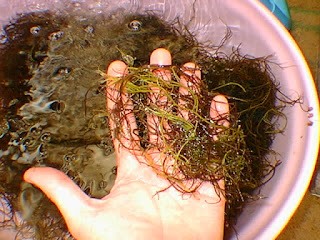Thursday, June 2, 2016
Gracilaria Lemaneiformis
Edible seaweed are low-calorie and packed with nutrients. Now scientists have found that a type of commercial red macroalgae could help counteract food allergies. They report their findings, using mice, in ACS’ Journal of Agricultural and Food Chemistry (May 17, 2016).
Food allergies are a major global health issue that can be life threatening. A 2014 study by researchers at Mount Sinai Hospital estimated that the condition affects about 8 percent of children and 5 percent of adults worldwide. In people who are allergic, certain compounds in food trigger a cascade of immune system reactions that lead to symptoms such as hives, wheezing and dizziness — and in the worst cases, anaphylactic shock.
Previous research has suggested that certain seaweed varieties contain polysaccharides with anti-asthmatic and anti-allergy effects. But no one had investigated whether similar molecules in #Gracilaria #lemaneiformis, a commercial variety of red algae, might have similar properties.
Guang-Ming Liu and colleagues wanted to find out. The researchers isolated polysaccharides from G. lemaneiformis and fed them to a group of mice sensitive to tropomyosin, a protein that is a major shellfish allergen. Another group of mice, also sensitive to tropomyosin, did not get the polysaccharides. After both groups were given the allergen, allergy symptoms in the treated mice were reduced compared to the untreated animals.
CCRES ALGAE TEAM part of Croatian Center of Renewable Energy Sources ( #CCRES )
Subscribe to:
Post Comments (Atom)




Gracilaria is a group of warm water seaweeds. There are more than one hundred species in the world, some of which have very important economic value. Gracilaria is used as food and in the preparation of food products.
ReplyDeleteOriginally and especially in China, Gracilaria species were used as food and as binding material in the preparation of lime for painting walls. Later, its use as food expanded to several Asiatic countries, until its content of agar were discovered by the Japanese and the western countries. A diversity of cultivation methods have been developed in different places, which is also consistent with the great variety of species of gracilarioids and their great range of temperature and latitudinal tolerance.
In the late fifties to early sixties, commercial cultivation was carried out in the Guangdong Province of China by inserting branches of the seaweed into splits of bamboo sticks about 15 cm. long, which were then planted in littoral farms. Later, cultivation of Gracilaria was carried out by scattering juvenile thallus fragments (5-6 cm. long) in littoral farms sheltered from wave action. Thalli in the fish ponds were covered with old fishing nets to avoid drifting. The method was initiated in Taiwan and by the late seventies, the Gracilaria ponds occupied over 200 hectares in area with production reaching over 6 800 tonnes and worth almost US$ 4 million. Experiments on growing Gracilaria in ponds or lagoons were later done in Brazil, Italy, Sri Lanka, Malaysia, Philippines and Japan. The method has proved to be successful in Taiwan province of China, China, Vietnam, Thailand and Indonesia.
Two cultivation methods of Gracilaria were developed in the 1980s. In St. Lucia, Lesser Antilles, Gracilaria was successfully cultivated on lines suspended near the surface by floating bamboo. These were later replaced by plastic bottles. A system of suspended cultivation with ropes and buoys was later developed in Namibia, while experiments with suspended ropes have been made also in Cuba, South Africa, India, the Philippines and New Zealand. At present, the most successful cultivation system with ropes and significant economic returns is being developed in China with Gracilariopsis lemanaeformis.
During the 1980s, a different cultivation method was developed in Chile. Because the thallus can survive burial in sandy mud for month, thallus fragments can be pushed in the mud with a fork or held down with sand-filled polyethylene tubing until the plants are established and growing. Harvesting is by hand, taking care not to remove the underground thalli. This method is the basis of the commercial production of Gracilaria chilensis and is confined to sheltered intertidal and shallow subtidal muddy sandy areas.
Experimental tank cultivation of Gracilaria also has proved to be technically feasible, first in Florida for energy and later in Sweden and Croatia, to improve agar quality and quantity.
We hope you and all your loved ones are healthy and safe. As a valued readers of CCRES, I wanted to first say thank you: Our newsletter subscriptions and website visits are increasing tremendously on a daily basis, and it’s thanks to you. We appreciate your trust in our journalism and we are working very hard in this time of crisis to keep you informed on all of the important developments. CCRES is supported by a mix of revenue streams including sponsorships, online advertising, funded projects, and policy debates. We know you value our reporting.This information should not be behind a paywall, and we remain committed to making our content widely available and our newsletters free. And we know your support is critical for ensuring this independent and free journalism. Zeljko Serdar, CCRES
ReplyDelete